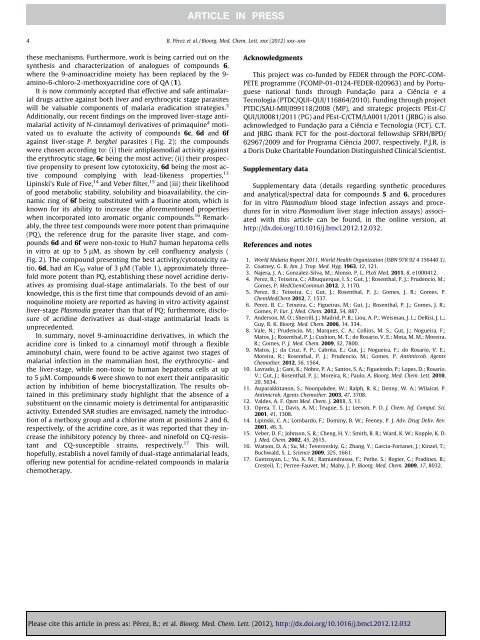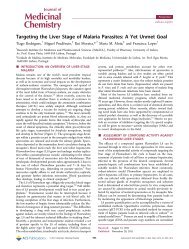Bioorganic & Medicinal Chemistry Letters - miguelprudencio.com
Bioorganic & Medicinal Chemistry Letters - miguelprudencio.com
Bioorganic & Medicinal Chemistry Letters - miguelprudencio.com
You also want an ePaper? Increase the reach of your titles
YUMPU automatically turns print PDFs into web optimized ePapers that Google loves.
4 B. Pérez et al. / Bioorg. Med. Chem. Lett. xxx (2012) xxx–xxx<br />
these mechanisms. Furthermore, work is being carried out on the<br />
synthesis and characterization of analogues of <strong>com</strong>pounds 6,<br />
where the 9-aminoacridine moiety has been replaced by the 9-<br />
amino-6-chloro-2-methoxyacridine core of QA (1).<br />
It is now <strong>com</strong>monly accepted that effective and safe antimalarial<br />
drugs active against both liver and erythrocytic stage parasites<br />
will be valuable <strong>com</strong>ponents of malaria eradication strategies. 3<br />
Additionally, our recent findings on the improved liver-stage antimalarial<br />
activity of N-cinnamoyl derivatives of primaquine 4 motivated<br />
us to evaluate the activity of <strong>com</strong>pounds 6c, 6d and 6f<br />
against liver-stage P. berghei parasites ( Fig. 2); the <strong>com</strong>pounds<br />
were chosen according to: (i) their antiplasmodial activity against<br />
the erythrocytic stage, 6c being the most active; (ii) their prospective<br />
propensity to present low cytotoxicity, 6d being the most active<br />
<strong>com</strong>pound <strong>com</strong>plying with lead-likeness properties, 13<br />
Lipinski’s Rule of Five, 14 and Veber filter, 15 and (iii) their likelihood<br />
of good metabolic stability, solubility and bioavailability, the cinnamic<br />
ring of 6f being substituted with a fluorine atom, which is<br />
known for its ability to increase the aforementioned properties<br />
when incorporated into aromatic organic <strong>com</strong>pounds. 16 Remarkably,<br />
the three test <strong>com</strong>pounds were more potent than primaquine<br />
(PQ), the reference drug for the parasite liver stage, and <strong>com</strong>pounds<br />
6d and 6f were non-toxic to Huh7 human hepatoma cells<br />
in vitro at up to 5 lM, as shown by cell confluency analysis (<br />
Fig. 2). The <strong>com</strong>pound presenting the best activity/cytotoxicity ratio,<br />
6d, had an IC 50 value of 3 lM (Table 1), approximately threefold<br />
more potent than PQ, establishing these novel acridine derivatives<br />
as promising dual-stage antimalarials. To the best of our<br />
knowledge, this is the first time that <strong>com</strong>pounds devoid of an aminoquinoline<br />
moiety are reported as having in vitro activity against<br />
liver-stage Plasmodia greater than that of PQ; furthermore, disclosure<br />
of acridine derivatives as dual-stage antimalarial leads is<br />
unprecedented.<br />
In summary, novel 9-aminoacridine derivatives, in which the<br />
acridine core is linked to a cinnamoyl motif through a flexible<br />
aminobutyl chain, were found to be active against two stages of<br />
malarial infection in the mammalian host, the erythrocytic- and<br />
the liver-stage, while non-toxic to human hepatoma cells at up<br />
to 5 lM. Compounds 6 were shown to not exert their antiparasitic<br />
action by inhibition of heme biocrystallization. The results obtained<br />
in this preliminary study highlight that the absence of a<br />
substituent on the cinnamic moiety is detrimental for antiparasitic<br />
activity. Extended SAR studies are envisaged, namely the introduction<br />
of a methoxy group and a chlorine atom at positions 2 and 6,<br />
respectively, of the acridine core, as it was reported that they increase<br />
the inhibitory potency by three- and ninefold on CQ-resistant<br />
and CQ-susceptible strains, respectively. 17 This will,<br />
hopefully, establish a novel family of dual-stage antimalarial leads,<br />
offering new potential for acridine-related <strong>com</strong>pounds in malaria<br />
chemotherapy.<br />
Acknowledgments<br />
This project was co-funded by FEDER through the POFC-COM-<br />
PETE programme (FCOMP-01-0124-FEDER-020963) and by Portuguese<br />
national funds through Fundação para a Ciência e a<br />
Tecnologia (PTDC/QUI-QUI/116864/2010). Funding through project<br />
PTDC/SAU-MII/099118/2008 (MP), and strategic projects PEst-C/<br />
QUI/UI0081/2011 (PG) and PEst-C/CTM/LA0011/2011 (JRBG) is also<br />
acknowledged to Fundação para a Ciência e Tecnologia (FCT). C.T.<br />
and JRBG thank FCT for the post-doctoral fellowship SFRH/BPD/<br />
62967/2009 and for Programa Ciência 2007, respectively. P.J.R. is<br />
a Doris Duke Charitable Foundation Distinguished Clinical Scientist.<br />
Supplementary data<br />
Supplementary data (details regarding synthetic procedures<br />
and analytical/spectral data for <strong>com</strong>pounds 5 and 6, procedures<br />
for in vitro Plasmodium blood stage infection assays and procedures<br />
for in vitro Plasmodium liver stage infection assays) associated<br />
with this article can be found, in the online version, at<br />
http://dx.doi.org/10.1016/j.bmcl.2012.12.032.<br />
References and notes<br />
1. World Malaria Report 2011, World Health Organization (ISBN 978 92 4 156440 3).<br />
2. Coatney, G. R. Am. J. Trop. Med. Hyg. 1963, 12, 121.<br />
3. Najera, J. A.; Gonzalez-Silva, M.; Alonso, P. L. PLoS Med. 2011, 8, e1000412.<br />
4. Perez, B.; Teixeira, C.; Albuquerque, I. S.; Gut, J.; Rosenthal, P. J.; Prudencio, M.;<br />
Gomes, P. MedChemCommun 2012, 3, 1170.<br />
5. Perez, B.; Teixeira, C.; Gut, J.; Rosenthal, P. J.; Gomes, J. R.; Gomes, P.<br />
ChemMedChem 2012, 7, 1537.<br />
6. Perez, B. C.; Teixeira, C.; Figueiras, M.; Gut, J.; Rosenthal, P. J.; Gomes, J. R.;<br />
Gomes, P. Eur. J. Med. Chem. 2012, 54, 887.<br />
7. Anderson, M. O.; Sherrill, J.; Madrid, P. B.; Liou, A. P.; Weisman, J. L.; DeRisi, J. L.;<br />
Guy, R. K. Bioorg. Med. Chem. 2006, 14, 334.<br />
8. Vale, N.; Prudencio, M.; Marques, C. A.; Collins, M. S.; Gut, J.; Nogueira, F.;<br />
Matos, J.; Rosenthal, P. J.; Cushion, M. T.; do Rosario, V. E.; Mota, M. M.; Moreira,<br />
R.; Gomes, P. J. Med. Chem. 2009, 52, 7800.<br />
9. Matos, J.; da Cruz, F. P.; Cabrita, E.; Gut, J.; Nogueira, F.; do Rosario, V. E.;<br />
Moreira, R.; Rosenthal, P. J.; Prudencio, M.; Gomes, P. Antimicrob. Agents<br />
Chemother. 2012, 56, 1564.<br />
10. Lavrado, J.; Gani, K.; Nobre, P. A.; Santos, S. A.; Figueiredo, P.; Lopes, D.; Rosario,<br />
V.; Gut, J.; Rosenthal, P. J.; Moreira, R.; Paulo, A. Bioorg. Med. Chem. Lett. 2010,<br />
20, 5634.<br />
11. Auparakkitanon, S.; Noonpakdee, W.; Ralph, R. K.; Denny, W. A.; Wilairat, P.<br />
Antimicrob. Agents Chemother. 2003, 47, 3708.<br />
12. Valdes, A. F. Open Med. Chem. J. 2011, 5, 11.<br />
13. Oprea, T. I.; Davis, A. M.; Teague, S. J.; Leeson, P. D. J. Chem. Inf. Comput. Sci.<br />
2001, 41, 1308.<br />
14. Lipinski, C. A.; Lombardo, F.; Dominy, B. W.; Feeney, P. J. Adv. Drug Deliv. Rev.<br />
2001, 46, 3.<br />
15. Veber, D. F.; Johnson, S. R.; Cheng, H. Y.; Smith, B. R.; Ward, K. W.; Kopple, K. D.<br />
J. Med. Chem. 2002, 45, 2615.<br />
16. Watson, D. A.; Su, M.; Teverovskiy, G.; Zhang, Y.; Garcia-Fortanet, J.; Kinzel, T.;<br />
Buchwald, S. L. Science 2009, 325, 1661.<br />
17. Guetzoyan, L.; Yu, X. M.; Ramiandrasoa, F.; Pethe, S.; Rogier, C.; Pradines, B.;<br />
Cresteil, T.; Perree-Fauvet, M.; Mahy, J. P. Bioorg. Med. Chem. 2009, 17, 8032.<br />
Please cite this article in press as: Pérez, B.; et al. Bioorg. Med. Chem. Lett. (2012), http://dx.doi.org/10.1016/j.bmcl.2012.12.032



